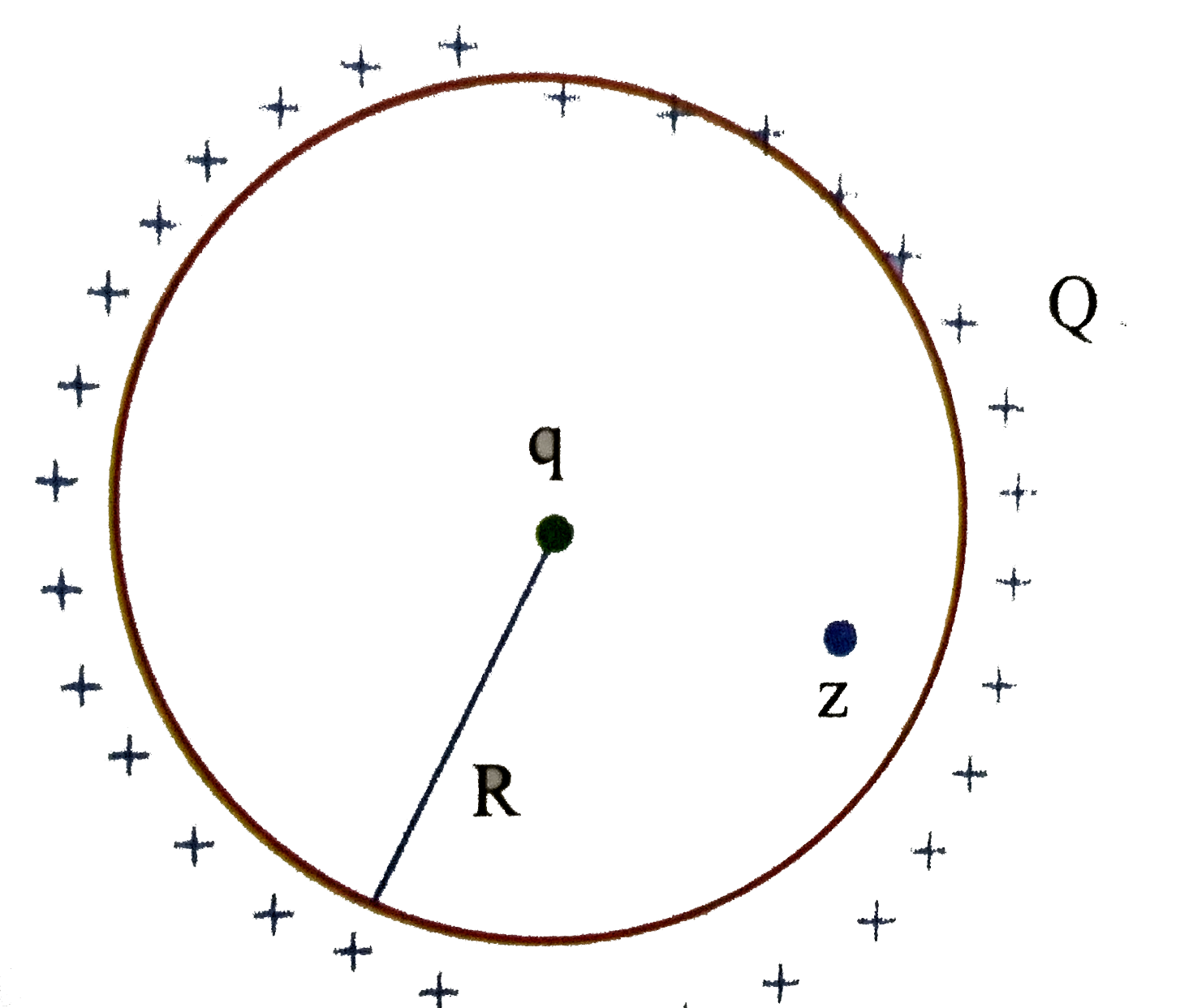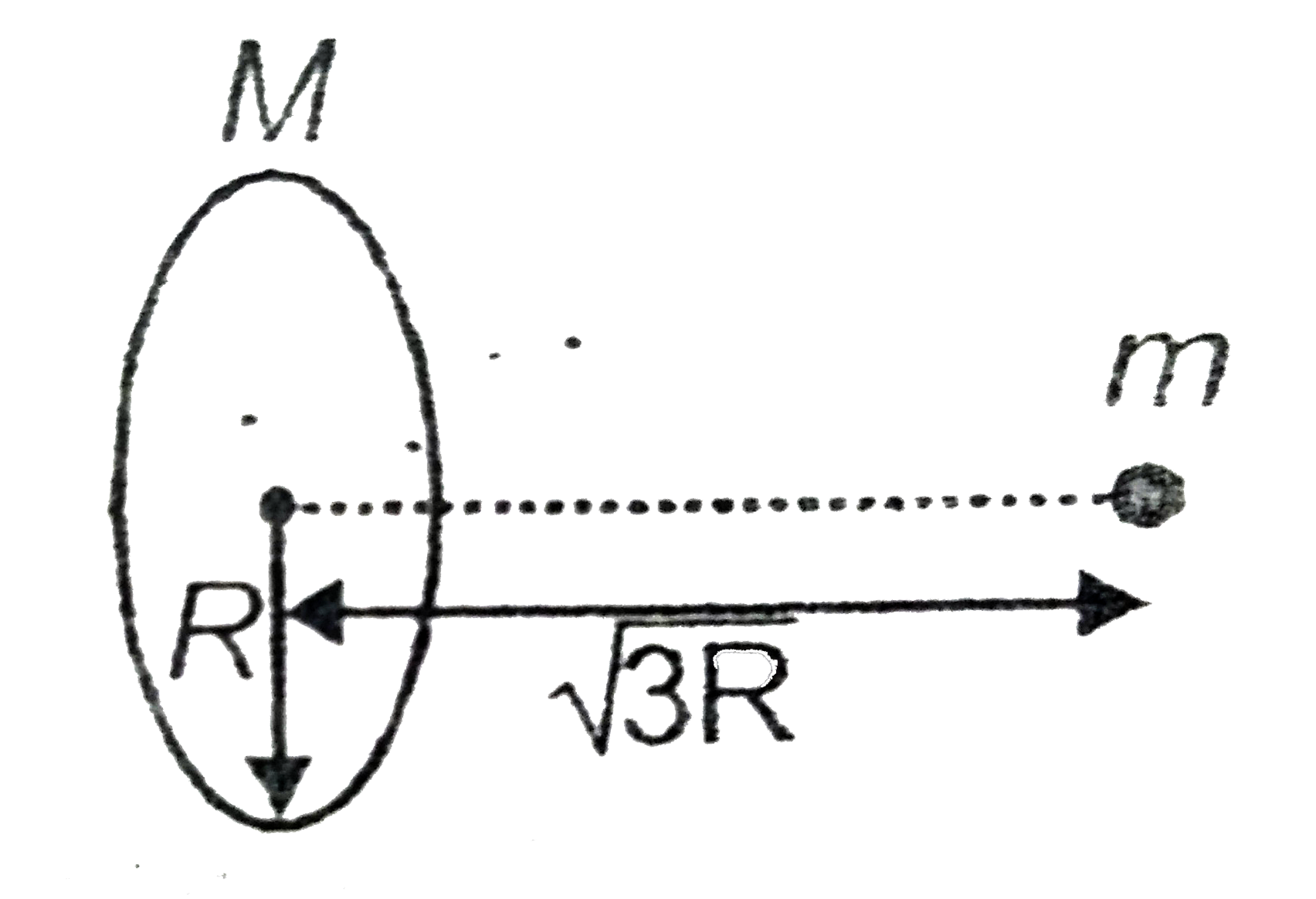A charge +Q is uniformly distributed over a thin ring with radius R. A negative point charge −Q and mass m starts from rest at a point far away from the centre of the ring and moves towards the centre. Find the velocity of this particle at the moment it passes through the centre of the ring .
The correct Answer is:√2KQ2mR
To find the velocity of the negative point charge −Q as it passes through the center of the ring, we can use the principle of conservation of energy. Here’s the step-by-step solution:
Step 1: Understand the Initial and Final States
Initially, the charge −Q is at rest at a point far away from the ring, where the potential energy is considered to be zero. As it moves towards the center of the ring, it will gain kinetic energy.
Step 2: Calculate the Potential Energy at Infinity
At a point far away from the ring, the potential energy (PE) of the charge −Q is zero:
\( PE_{\text{initial}} = 0 \)
Step 3: Calculate the Potential Energy at the Center of the Ring
When the charge −Q is at the center of the ring, it experiences a potential due to the uniformly distributed charge +Q. The potential \( V \) at the center of the ring due to a ring of charge is given by:
\( V = \frac{kQ}{R} \)
where \( k \) is Coulomb's constant.
The potential energy (PE) of the charge −Q at the center of the ring is:
\( PE_{\text{final}} = -Q \cdot V = -Q \cdot \frac{kQ}{R} = -\frac{kQ^2}{R} \)
Step 4: Apply Conservation of Energy
According to the conservation of energy, the total mechanical energy remains constant. Thus, the initial potential energy plus the initial kinetic energy equals the final potential energy plus the final kinetic energy:
\( PE_{\text{initial}} + KE_{\text{initial}} = PE_{\text{final}} + KE_{\text{final}} \)
Since the charge starts from rest:
\( 0 + 0 = -\frac{kQ^2}{R} + \frac{1}{2} mv^2 \)
Step 5: Rearranging the Equation
Rearranging the equation gives:
\( \frac{1}{2} mv^2 = \frac{kQ^2}{R} \)
Step 6: Solve for Velocity \( v \)
Multiplying both sides by 2 and solving for \( v \):
\( mv^2 = \frac{2kQ^2}{R} \)
\( v^2 = \frac{2kQ^2}{mR} \)
\( v = \sqrt{\frac{2kQ^2}{mR}} \)
Final Answer
The velocity of the particle at the moment it passes through the center of the ring is:
\( v = \sqrt{\frac{2kQ^2}{mR}} \)
---
Initially, the charge −Q is at rest at a point far away from the ring, where the potential energy is considered to be zero. As it moves towards the center of the ring, it will gain kinetic energy.
At a point far away from the ring, the potential energy (PE) of the charge −Q is zero:
\( PE_{\text{initial}} = 0 \)
When the charge −Q is at the center of the ring, it experiences a potential due to the uniformly distributed charge +Q. The potential \( V \) at the center of the ring due to a ring of charge is given by:
\( V = \frac{kQ}{R} \)
where \( k \) is Coulomb's constant.
\( PE_{\text{final}} = -Q \cdot V = -Q \cdot \frac{kQ}{R} = -\frac{kQ^2}{R} \)
According to the conservation of energy, the total mechanical energy remains constant. Thus, the initial potential energy plus the initial kinetic energy equals the final potential energy plus the final kinetic energy:
\( PE_{\text{initial}} + KE_{\text{initial}} = PE_{\text{final}} + KE_{\text{final}} \)
\( 0 + 0 = -\frac{kQ^2}{R} + \frac{1}{2} mv^2 \)
Rearranging the equation gives:
\( \frac{1}{2} mv^2 = \frac{kQ^2}{R} \)
Multiplying both sides by 2 and solving for \( v \):
\( mv^2 = \frac{2kQ^2}{R} \)
\( v^2 = \frac{2kQ^2}{mR} \)
\( v = \sqrt{\frac{2kQ^2}{mR}} \)
The velocity of the particle at the moment it passes through the center of the ring is:
\( v = \sqrt{\frac{2kQ^2}{mR}} \)
Topper's Solved these Questions
- MISCELLANEOUSBook:ALLENChapter:MISCELLANEOUSExercise:Exersice-04[B]
Explore 16 Videos
- MISCELLANEOUSBook:ALLENChapter:MISCELLANEOUSExercise:Exercise-05(A)
Explore 35 Videos
- MISCELLANEOUSBook:ALLENChapter:MISCELLANEOUSExercise:Comprehension 9
Explore 2 Videos
- KINEMATICS (MOTION ALONG A STRAIGHT LINE AND MOTION IN A PLANE)Book:ALLENChapter:KINEMATICS (MOTION ALONG A STRAIGHT LINE AND MOTION IN A PLANE)Exercise:BEGINNER S BOX-7
Explore 8 Videos
- PHYSICAL WORLD, UNITS AND DIMENSIONS & ERRORS IN MEASUREMENT Book:ALLENChapter:PHYSICAL WORLD, UNITS AND DIMENSIONS & ERRORS IN MEASUREMENT Exercise:EXERCISE-IV
Explore 8 Videos
Similar Questions
Electric charge Q is uniformly distributed around a thin ring of radius a. find the potential a point P on the axis of the ring at a distance x from the centre of the ring .

View SolutionCharge q is uniformly distributed over a thin half ring of radius R. The electric field at the centre of the ring is
View SolutionA positive charge Q is uniformly distributed along a circular ring of radius R.a small test charge q is placed at the centre of the ring.

View SolutionA point particle of mass m is released from a distance √3R along the axis of a fixed ring of mass M and radius R as shown in figure. Find the speed of particle as it passes through the centre of the ring.

View SolutionA positive charge Q is uniformly distributed along a circular ring of radius R.a small test charge q is placed at the centre of the ring .The

View SolutionA charge +Q is uniformly distributed over a thin ring of the radius R. The velocity of an electron at the moment when it passes through the centre O of the ring, if the electron was initially at far away on the axis of the ring is (m=mass of electron, K=14πε0)
View SolutionA charge q is uniformly distributed over a quarter circular ring of radius r. The magnitude of electric field strength at the centre of the ring will be
View SolutionA charge q is uniformly distributed on a non-conducting disc of radius R. It is rotated with an angular speed co about an axis passing through the centre of mass of the disc and perpendicular to its plane. Find the magnetic moment of the disc.
View SolutionA charge q is unifomly distrybuted over a nonconducting ring of radius R. The ring is rotated about an axis passing through its centre and perpendicular to the plane of the ring with frequency f. The ratio of electric potential to the magnetic field at the centre of the ring depends on.
View SolutionSTATEMENT 1: When a negative charge -q is released at a distance R from the centre and along the axis of a uniformly and positvely charged fixed ring of radius R, the negative charge does oscillation but not SHM. STATEMENT 2: The force on negative charge is always towards the centre of the ring but it is not proportional to the displacement from the centre of the ring.
View Solution
